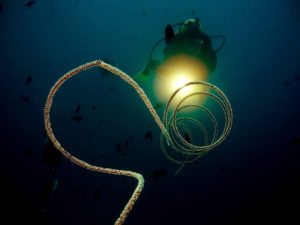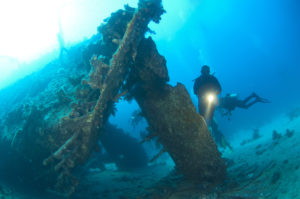After passing their PADI Open Water course, many divers are anxious to complete their PADI Advanced Open Water Diver training. But what does the course entail? How do you choose the right PADI advanced open water adventure dives to get the most from the course? PADI revised the Advanced Open Water course in 2016 and now, more than ever, it offers divers the opportunity to broaden their diving knowledge and skills.
Getting your AOW
Made up of five adventure dives, the course builds on the diving fundamentals of the PADI Open Water course. It adds a degree of task loading and forces you to begin “thinking like a diver.” Two of the five adventure dives are mandatory — Deep and Underwater Navigation. Planning and safely executing deeper dives, combined with the ability to navigate a dive site, have always been prerequisites of the Advanced Open Water qualification. Now, however, there is increased emphasis on gas management and computer usage.
That leaves a whole host of Adventure Dives from which you’ll select just three. What are they? Which ones should you choose? The options are as follows:
- Altitude
- Boat
- Cavern*
- DSMB*
- Digital Underwater Imaging
- Dive Against Debris (AWARE)*
- DPV*
- Drift
- Dry Suit
- Enriched Air*
- Fish ID
- Full Face Mask*
- Ice*
- Night
- Peak Performance Buoyancy
- Rebreather*
- Search & Recovery
- Self-Reliant*
- Shark Conservation (AWARE)*
- Sidemount*
- Underwater Naturalist
- Wreck
This list should help you understand the philosophy of the course, which is to offer a taste of many types of diving. If you enjoy one particularly, you can pursue it through specialty training. For instance, to obtain a full Wreck Diving Specialty Diver rating requires a minimum of three more dives with the corresponding training.
Bear in mind that local environment and the facilities and logistics of the dive center will dictate your choices somewhat. You’re not going to take a drysuit course in the tropics or wreck dive where there are no wrecks, for example.
What’s your diving future?
Before beginning, consider what types of dives you’ll do in the future. Essentially, you have three options. If you see yourself as primarily a recreational diver in the future, choose the areas that interest you, whether that’s underwater photography, Fish ID, or what have you. Or choose dives that will be useful in your local environment, such as Altitude or Dry Suit.
The second diving path you may take is as a technical diver. If this is the case, Enriched Air, Self-Reliant, Sidemount or Rebreather training will be key. As mentioned earlier, much will depend on the logistical availability at the dive center.
Finally, if you see yourself becoming a dive professional, you’ll need certain prerequisite skills. Even so early on in your dive career as Advanced Open Water, these are arguably the best options for your specialty classes if you want to go pro.
Boat
Most diving take place from boats, whether day boats, RIBs or liveaboard vessels. Having a basic knowledge of boat procedures and boat diving will stand you in good stead as you progress through Rescue Diver and Divemaster courses, where you’ll spend much of your time supervising divers on boats. DSMB/SMB usage is also a key skill for boat diving.
Night
Night diving is popular among vacationing recreational divers. This kind of diving requires different signaling, equipment and planning considerations, both above and below the surface. As a Divemaster, you’ll be expected to have experience in planning and executing night dives, so start getting some practice early on.
Peak Performance Buoyancy
Buoyancy control is the key to diving. This AOW adventure dive focuses on the best techniques for enhancing this essential skill. The best divers can simply hang in the water, pivot through their center points and reverse through the water without sculling and flapping their hands. Fine-tuning your buoyancy, while not as immediately appealing as a DPV dive for example, will pay dividends as you progress further in your diving. Your confidence and gas consumption will improve as well, along with your buoyancy control.
Search and Recovery
During this adventure dive, you’ll gain valuable experience in underwater search patterns, underwater knot tying (bowline, two half-hitches and sheet bend), and using a lift bag to recover an object from the seabed. As with night diving, search and recovery skills are a prerequisite of Divemaster training. Getting a foundation here will help you progress through Rescue Diver and Divemaster training.
Enriched Air
Both recreational and professional divers commonly use Enriched Air, sometimes known as EANX or nitrox. The Enriched Air Diver course is essential these days. The gas laws that you’ll learn to apply when planning enriched-air dives will also apply if you progress in technical diving. Doing the Enriched Air Adventure Dive is a great starting point.
 Wreck
Wreck
Whether you’re interested in the history, the challenge, or the aquatic life these structures attract, there’s something for everyone when it comes to wreck diving. Many resorts and liveaboards offer wreck dives. The Wreck Adventure Dive is a great foundation in basic wreck diving, and will help you decide if you want to pursue it further. Students begin thinking about wreck dive planning, wreck assessment, wreck navigation and hazard identification. These are key skills for a Divemaster working in the wreck-diving environment as well.
The PADI Advanced Open Water course is a great stepping-stone to further diving adventures. With 22 potential Advanced Open Water Adventure dives, choose carefully to get the most from your course and begin planning your future in diving.
* A Specialty Diver Instructor must conduct these classes



